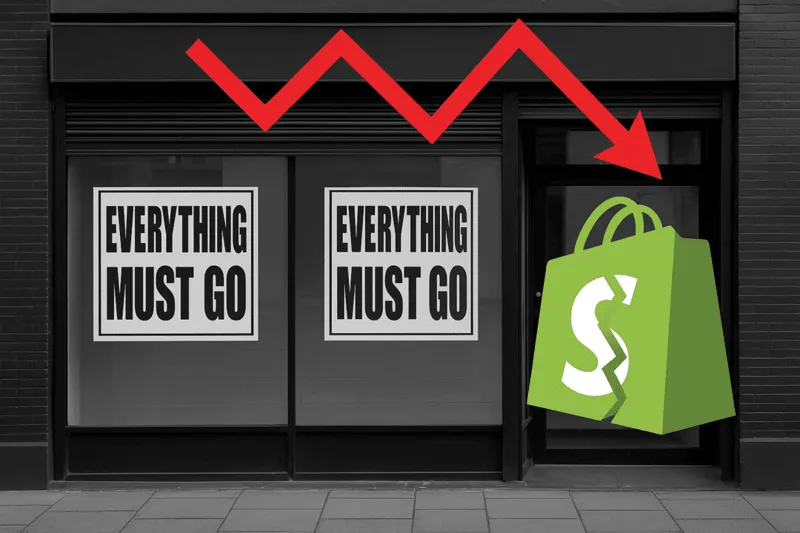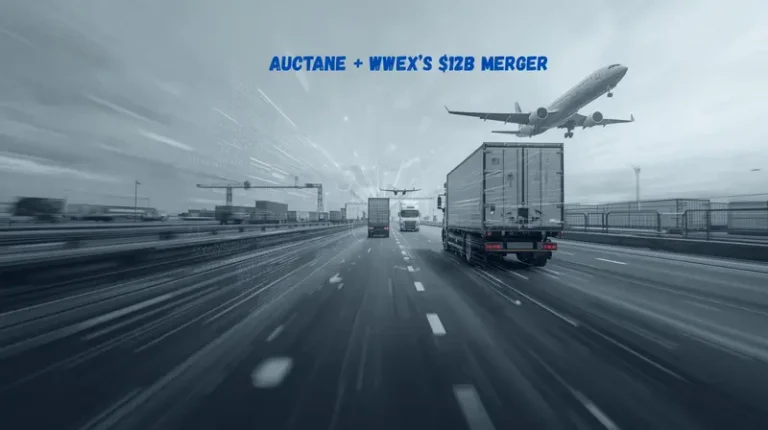DTC Brands Are Dying Faster Than Ever

Last updated on July 15, 2025

Ecommerce isn’t just cooling off; it’s contracting
In Q2 2025, Shopify store closures outpaced new installs for the first time ever: 1.5 closures per new store. That’s not a blip. That’s a reckoning.
Revenue for small DTC brands is down 25% year over year. The overall DTC market is down 9%. And consumer spending sentiment is the weakest it’s been since 2023. Just in April, 1% of DTC brands filed for Chapter 11. That’s a flood.
So what’s going on? Why now? And what can you actually do about it if you run a brand or support one?
The “Why” Behind the Collapse
Tariffs + Inventory = Cash Flow Crisis
Here’s the brutal math: tariffs go up; landed cost skyrockets. And a lot of brands placed orders ahead of the tariff hikes, only to watch demand dry up. Now they’re sitting on overpriced inventory they can’t move, tying up precious cash. Inventory isn’t just stuff on shelves; it’s money trapped in cardboard.
CAC Is Climbing; Retention Isn’t Saving You
Customer acquisition costs are going up, just as the effectiveness of paid channels is going down. Even retention can’t save you when consumers are delaying purchases or trading down to cheaper alternatives. Many brands already pulled future revenue forward during the 2020–2022 boom. Now, there’s nothing left to squeeze.
Post-COVID Saturation Is Real
Let’s be honest: not every brand deserves to exist. Many were spun up with plug-and-play toolkits and cheap paid ads. That worked when capital was cheap and consumers were bored. Now? The music stopped. And not everyone found a chair.
Slash Your Fulfillment Costs by Up to 30%
Cut shipping expenses by 30% and boost profit with Cahoot's AI-optimized fulfillment services and modern tech —no overheads and no humans required!
I'm Interested in Saving Time and MoneyWhy Now?
A few reasons:
- Macroeconomic headwinds: Tariffs, inflation, and consumer anxiety are colliding.
- The era of easy VC money is over: Brands are being forced to act like real businesses.
- Platform fatigue: Shopify, Amazon, and TikTok Shops are crowded and expensive to win on.
This isn’t just a cyclical dip; it’s a structural correction. We’re witnessing the clearing of an ecosystem that got way too crowded, way too fast.
Who’s Most Vulnerable?
Brands that were built on borrowed time and easy growth:
- Brands with high CACs and low AOVs
- Brands heavily reliant on paid social for discovery
- Brands with no supply chain flexibility
- Brands without real community, loyalty, or differentiation
Real examples:
- Flaus canceled a $30K Hamptons pop-up.
- Beau Ties of Vermont cut staff hours.
- Loftie saw lamp sales drop 80%.
What You Can Do
Audit Your Cash Flow Now
Know exactly how many months of runway you have, with and without new revenue. Get real about your burn and where the landmines are.
Recalculate Your CAC & Contribution Margins
Don’t just look at blended ROAS. Look at the actual contribution margin after fulfillment, returns, payment fees, and platform costs. If you’re underwater on a hero SKU, fix it or cut it.
Diversify Fulfillment & Cut Ops Costs
With tariffs, shipping surcharges, and inflation hitting from all angles, fulfillment is your biggest lever. Use it. A partner like Cahoot can unify fulfillment across channels, reduce shipping zones, and preserve margins.
Reprioritize Community, Not Just Campaigns
Start building real relationships, not just funneling ad dollars. Brands with real communities are taking less of a hit right now. That’s not a coincidence.
Looking for a New 3PL? Start with this Free RFP Template
Cut weeks off your selection process. Avoid pitfalls. Get the only 3PL RFP checklist built for ecommerce brands, absolutely free.
Get My Free 3PL RFPWhat the Future Looks Like
It’s going to get worse before it gets better.
Expect more closures, more acquisitions, and more consolidation. But also: the strongest brands, the ones with real margins, operational discipline, and customer loyalty, will finally have room to grow again.
This moment is painful, but it’s also clarifying. The ecosystem can’t support 100 brands selling the same $49 water bottle with a different logo. The brands that survive this cycle will be the ones that finally build a real business.
Frequently Asked Questions
What’s causing the DTC brand collapse in 2025?
Tariffs, inflation, rising customer acquisition costs, and oversaturation in key categories are squeezing margins and killing demand.
Why are so many Shopify stores shutting down?
Closures now outpace new installs. Many brands can’t survive rising CAC, unsold inventory, and cash flow pressure.
Are all DTC brands at risk?
Not all, but the most vulnerable are those reliant on paid acquisition, single-channel sales, or undifferentiated products.
Are Shopify brands more vulnerable than Amazon sellers?
Often, yes; Amazon sellers may have more built-in demand and streamlined fulfillment.
What categories are getting hit hardest by the economic pressures of 2025?
Home goods, wellness, and accessories have seen the sharpest demand drop.
What can DTC operators do right now?
Get ruthless on cash flow, margins, and operational flexibility. Cut burn, audit margins, diversify fulfillment, and refocus on loyalty and community. Flexible, scalable fulfillment can reduce overhead and improve margins, crucial for survival.
Citations
- Tariffs Trigger the Sharpest Drop in Online Spending in Over a Decade: Read more.
- Faced with economic anxiety, retailers pare expectations for the year: Read more.
- Brands grapple with strained cash flow amid tariffs: Read more.
- US prices for China-made goods rise faster than inflation, analysis shows, as tariffs bite: Read more.
- US prices for China-made goods sold on Amazon rising faster than inflation: Read more.

Turn Returns Into New Revenue


 4 minutes
4 minutes


